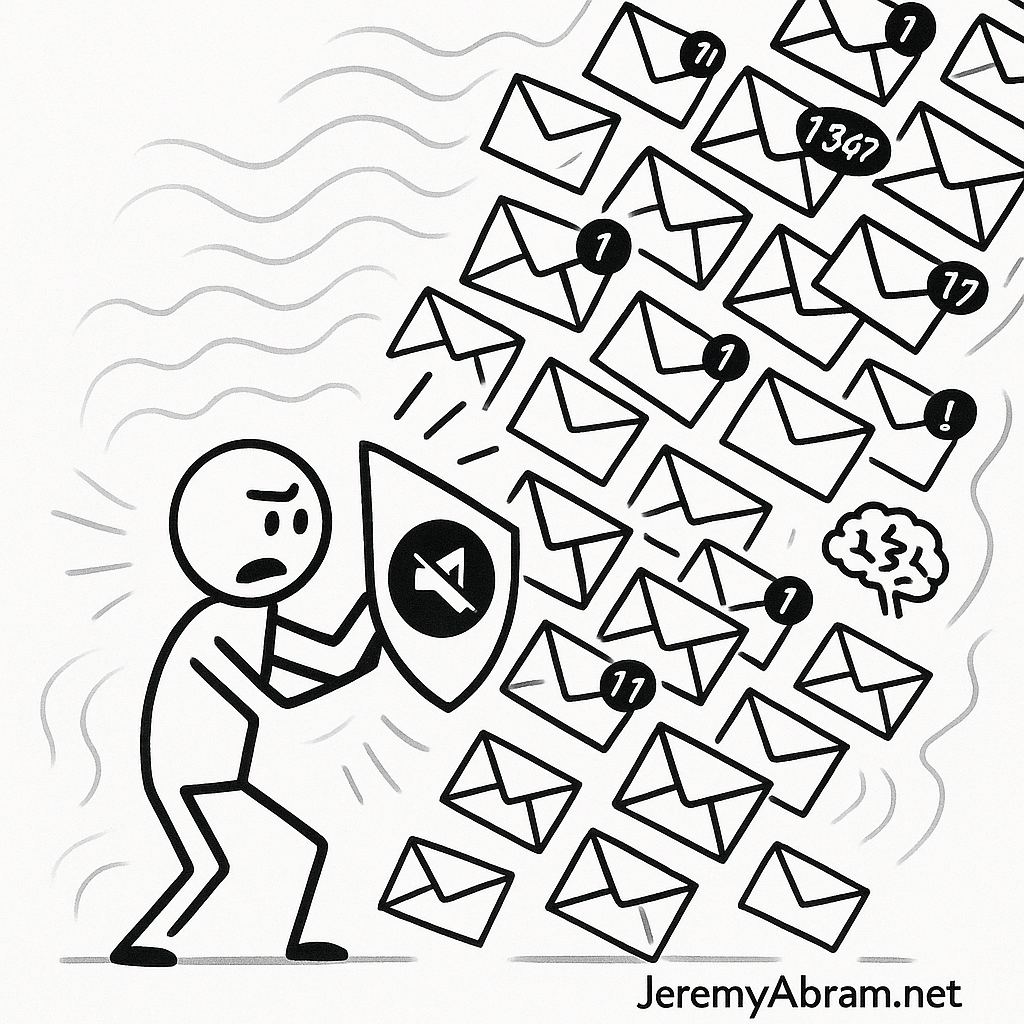
by JeremyAbram.net
The Age of Inbox Anxiety
It starts innocently enough: a quick refresh of your inbox before coffee. Then, before you know it, you’ve lost 40 minutes triaging threads, deleting newsletters, and rereading “urgent” requests that weren’t urgent at all.
Email — once the backbone of digital communication — has evolved into a source of persistent cognitive interference, quietly eroding focus, creativity, and even professional confidence.
Today, the average office worker receives 121 emails per day and sends about 40. That’s over 30,000 incoming messages a year — not including personal accounts or promotional clutter. For many, the inbox has become less a tool and more a psychological battleground.
The Psychology of Email Fatigue
At its core, email fatigue isn’t just about volume — it’s about expectation. Every message represents a potential demand, a decision point, or a social cue. Each unread count silently whispers something is waiting.
Behavioral researchers have long linked constant digital interruption to decision fatigue and attention residue — the lingering mental cost of switching tasks before fully completing one. When the inbox becomes an open channel of uncertainty, your brain treats every notification like a small alarm. Dopamine spikes at the arrival of a new message, followed by cortisol when you realize it’s yet another “FYI” thread.
Over time, this cycle conditions us toward reactivity, not reflection — reinforcing a productivity illusion: the sense of being busy without meaningful progress.
Attention Fragmentation: The Hidden Cost
Every glance at your inbox fractures focus. Studies from the University of California, Irvine found that workers interrupted by email take up to 23 minutes to fully regain their prior level of concentration. That’s not multitasking — it’s micro-burnout.
Email’s asynchronous design, once considered its greatest strength, now fuels cognitive clutter. Notifications ping at all hours, creating a false sense of urgency. The average professional checks their email 11 times per hour, and nearly 60% of people respond within an hour — even when not required to.
The result is a constant tug-of-war between available attention and ambient obligation.
The Productivity Bias: When Efficiency Turns Against You
Email gives the illusion of efficiency — the quick reply, the cleared inbox, the “sent” confirmation that feels like progress. But this productivity bias masks a deeper truth: most email activity serves internal reassurance, not external impact.
We reward ourselves for being seen responding, not for creating lasting value. It’s the digital equivalent of tidying your desk every ten minutes while your real work gathers dust.
Automation and smart sorting filters promise relief, yet they often backfire — encouraging us to process more messages instead of questioning whether those messages need to exist at all. In the language of behavioral economics, email becomes a feedback loop of low-yield productivity: high activity, low reward.
Inbox as Noise: The Cognitive Clutter Model
Think of your brain as a limited-bandwidth system. Each incoming email occupies a fraction of that bandwidth, even if unread. It’s not unlike having 200 open browser tabs — most of them silent, but all consuming memory.
This cognitive clutter creates what psychologists call ambient anxiety — a subtle but persistent awareness of unfinished communication. The inbox transforms from a tool of clarity into a mirror of accumulated digital noise.
And noise, by definition, obscures signal. When everything demands your attention, nothing truly receives it.
Escaping the Inbox Trap
1. Rethink Your Response Habit
Not every message deserves a reply — or an instant one. Set clear boundaries with auto-responses (“I check email twice daily”) or structured time blocks. Responsiveness isn’t the same as reliability.
2. Use Filters as Firewalls, Not Funnels
Instead of using filters to prioritize more emails, use them to quarantine less relevant ones. Create a “digest” folder for newsletters and batch-read weekly.
3. Practice the “Two-Minute Rule” Wisely
The classic productivity hack — handling any email that takes less than two minutes immediately — can quickly become a trap. Reserve it for truly transactional items, not as an excuse for constant context-switching.
4. Audit the Source of Noise
Unsubscribe aggressively. Challenge your organization’s email culture. Ask: Could this be a shared doc? A quick call? A project management update?
Reducing volume at the source is the only true path to relief.
5. Redefine Productivity Metrics
Shift from measuring speed of reply to depth of output. Quality focus time beats inbox zero every time.
The Broader Lesson: Attention Is the New Bandwidth
Email overload is not just a workplace issue — it’s a microcosm of digital life. Every channel competes for attention, every notification a tug on your limited cognitive rope.
In this ecosystem, the winners are not those who communicate fastest, but those who guard their focus most fiercely.
When your inbox becomes noise, the real act of productivity is learning how — and when — to mute it.
JeremyAbram.net
Exploring the hidden layers of digital life, data culture, and the psychology of modern tech.
Leave a Reply